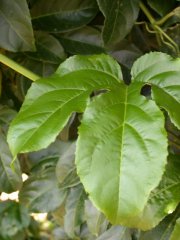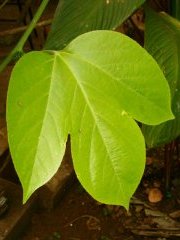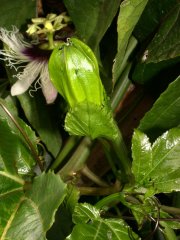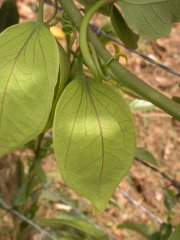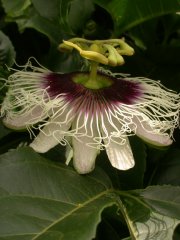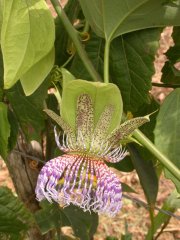 |
QUICK SEARCH
MO PROJECTS:
Africa
Asia/Pacific
Mesoamerica
North America
South America
General Taxonomy
Photo Essays
Training in Latin
America
MO RESEARCH:
Wm. L. Brown Center
Bryology
GIS
Graduate Studies
Research Experiences
for Undergraduates
Imaging Lab
Library
MBG Press
Publications
Climate Change
Catalog Fossil Plants
MO DATABASES:
W³MOST
Image Index
Rare Books
Angiosperm
Phylogeny
Res Botanica
All Databases
INFORMATION:
What's New?
People at MO
Visitor's Guide
Herbarium
Jobs & Fellowships
Symposium
Research Links
Site Map
Search
|
Draft Treatments | Guidelines | Checklist | Citing | Editors The Cutting EdgeVolume XIV, Number 2, April 2007News and Notes | Leaps and Bounds | Germane Literature | Season's Pick Passiflora edulis Sims and P. platyloba Killip (Passifloraceae): a mystery in two stages, down on the farm. The root of this mystery is in our kitchen middens: we always use the biodegradable waste from our kitchen as mulch, fertilizer, and occasional source of seedlings, at the base of various ornamental or fruit trees in our yard. From that seed source, about a year ago, sprouted two different kinds of passion fruit vines, leaves of both resembling the Maracuyá (P. edulis), which we often use to make juice. We also occasionally eat the sweeter, but not for juice, Granadilla (P. ligularis Juss.), a species we also have growing from the same seed source, but it has unlobed leaves, and is not involved in the present mystery.
Our first, erroneous, assumption was that we had inadvertently eaten the two forms of P. edulis: f. edulis (Estococa, Granadilla, Granadilla morada, Granadina, Tococa), rarely, if at all, found in Costa Rican markets these days, and f. flavicarpa O. Deg., the Maracuyá.
Both vines are flowering profusely this year, and the accumulation of vegetative and floral differences (petiolar glands at top of petiole, vs. from middle to bottom; stipules filiform and eglandular, vs. falcate and orange-glanduliferous; bracts dentate, vs. entire; flowers erect, vs. pendent; and so on) were more than enough to give us suspicion that two species were involved. In fact, as confirmed by Manual Passiflora contributor Alexánder Rodríguez (INB), the left column of photos and respective first-stated characters, pertain to P. edulis f. flavicarpa, while the right column is P. platyloba, an uncommon native species from dry to moist forest, and not known from above 600 m (our finca is at 1200m and falls within the very wet or rainforest category of the Holdridge system!). And that is the part of this mystery that remains unsolved: how did a seed from a native species, not known from the Central Valley, get to our kitchen middens? Does the grower who supplies the fruit stand where I shop sell a mixture of these species as Maracuyá? Or is this dry-forest species extending its range?
|
© 1995-2025 Missouri Botanical Garden, All Rights Reserved
4344 Shaw Blvd.
St. Louis, MO 63110
(314) 577-5100
Technical Support
